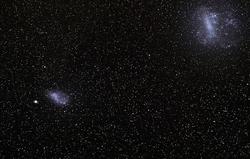Daily Report 3 -- Tuesday, 28 February 2012 -- Orion Does a Cartwheel: The Southern Skies
Let’s take a step outside… it’s after my shift, so it is 1:30am and it is pitch black out on the deck. After a few minutes of staring into the dark, my eyes adjust and a swath of white specks reveals itself across the sky. For an amateur star gazer, it is immediately noticeable that these stars are alien and unfamiliar to a Northern Hemisphere boy. Here are a few things that stand out to me…
Any recognizable stars are ‘upside-down’ and closer to the Northern horizon instead of the Southern. The first familiar constellation that comes into sight is Orion. Instead of ‘walking’ along the Southern horizon as he does in the North, he casually cartwheels overhead throughout the night. Other nearby constellations can be observed; the same, yet different as they are being viewed from a different angle. Canis Major is on its ‘back’ with Sirius (it’s nose) pointing the other way and Gemini has flipped over so that Castor and Pollux have switched places.
Compared to the North, many Southern Constellations are dim, roughly shaped, and awkwardly named. While constellations in the North originated from ancient cultural history, many modern recognized constellations in the South were named in the Age of Exploration and contain such whimsical names as Microscopium, Sextans, and Telescopium. While many of the constellations are down right uninteresting to look at, there are a few objects in the sky that draw ones eye. The Southern Cross (Crux) can perhaps be considered a mascot of the Southern skies and is visible almost directly overhead and generally points to the South Pole. This constellation is so well known and acknowledged that it is found in music, literature/ media, and even on multiple nation flags throughout the Southern half of the world.
One feature that always dominates the night sky is the Milky Way. The Earth’s South Pole is slightly angled toward the galactic center so you gaze more into the bulk of the galaxy. As a result, the Southern Milky Way has many more features to it and dark regions (dust clouds) are much more prominent. Of particular note is an apparent gaping hole in the galaxy just next to Crux. This hole is known as the ‘Coalsack’ and it is a dark nebula of dust within the galaxy. Along with this prominent dark spot, streaks of black stretch across the Milky Way and give it character not found in the North.
Some ancient Southern cultures created dark cloud constellations as the features are just as (if not more) prominent than stars in the sky. Australian Aboriginal cultures named a constellation characterizing the dark patches of the Milky Way as the ‘Emu in the Sky’ with the Coalsack as its head. Looking a bit to the side of the galaxy, almost out of place and standing alone as if wanting to be noticed are the Magellanic Clouds. These features are only visible in the Southern Hemisphere and are actually two nearby dwarf galaxies that orbit our own Milky Way. Nothing like this is seen in the Northern skies and it is certainly unique to see other nearby galaxies that feature so conspicuously in the sky.
 While I can sort of make out the Emu, I am more entranced by how different the Milky Way and sky look in general. In familiar skies, I find myself searching and checking the position of known stars and planets like a machine… but with such a new wondrous sky to behold, I find myself back to basics and lost in its wonder. Losing myself in the stars I fell asleep in a plastic chair on the deck. By the time I woke up, Orion was hitting his head on the horizon.
While I can sort of make out the Emu, I am more entranced by how different the Milky Way and sky look in general. In familiar skies, I find myself searching and checking the position of known stars and planets like a machine… but with such a new wondrous sky to behold, I find myself back to basics and lost in its wonder. Losing myself in the stars I fell asleep in a plastic chair on the deck. By the time I woke up, Orion was hitting his head on the horizon.
Shawn Morrish
- 7800 reads

